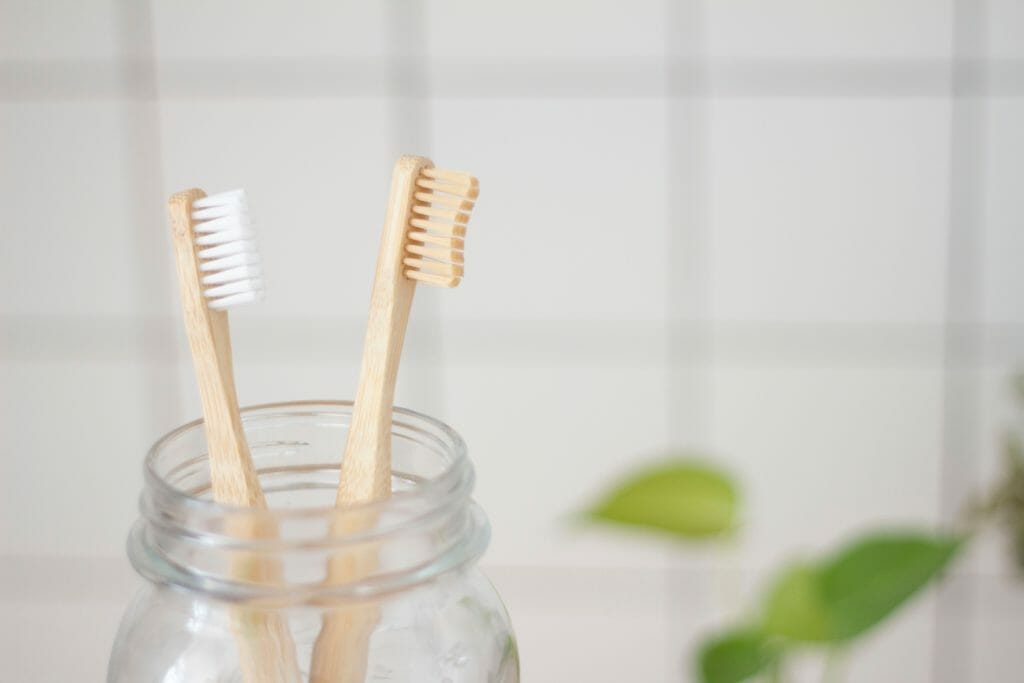Contrary to what we’ve been told growing up, the goal is not to kill, kill, kill all the germs in your mouth through regularly vigorous tooth brushing and anti-bacterial mouthwashes. Some bacteria actually promote good health in your mouth and subsequently throughout the body – like the heart – in the same way that certain strains of bacteria positively influence other systems in the body – namely the gut bacteria interactions with the brain and immune system. We’re all familiar with the gut microbiome – the mix of beneficial and pathogenic species of bacteria that reside within the gut – but research is beginning to reveal just how important our oral microbiome balance of bacteria is to our health and why it should not be overlooked.
Oral microbiome

You’re probably familiar with the notion of trillions of bacteria residing in the small and large intestines that play a role in many areas of health through connections with the brain, nervous and immune systems, as well as ensuring the correct environment in the digestive tract for dietary nutrients to be absorbed.
But there’s more to this story. The opening of the digestive tract is, in fact, the mouth which contains many different species of bacteria that can benefit, as well as hinder, our health. The mouth is the first meeting place between the alimentary canal (the entire passage along which food passes through the body), the immune system, and the outside world so it’s pretty important!
The mouth has a variety of microenvironments that host different bacterial populations: the tongue, the hard palate, the teeth, the area around the tooth surfaces, above the gums and below the gums. Around 700 species of aerobic and anaerobic organisms are known to live in the mouth and are organised in communities commonly referred to as biofilms. [1,2] The balance of bacterial species in the oral microbiome has long been ignored but it’s every bit as essential as a healthy gut microbiome.
Research suggests that there is up to a 45% overlap of bacteria in the mouth and colon. Some scientists claim we may swallow up to one trillion bacteria every day implicating the oral microbiome as an important source of continuous bacteria seeding within the gastrointestinal tract.
As far as the groups of bacteria in the mouth versus the colon, there is still a lot to learn, as this requires researching trillions of bacteria and thousands of bacterial species. What we currently know is that predominance of Streptococcus is the hallmark of the oral microbiome. It seems evident that several Streptococcus species are a health group of bacteria that colonise the mouth in all people. Bacteroidetes and Firmicutes are the primary phyla (or supergroups) found in the colon, which also reside within the mouth.
There are other parallels between the oral microbiome and gastrointestinal microbiome. Research shows that infants born vaginally have more bacteria and more diverse bacteria in the mouth as well as in the gut compared to infants born by caesarean section. Infants born by caesarean section were found to have a higher prevalence of the periodontal pathogen, Slacki exigua, in the oral cavity, in part due to the reduced oral bacterial diversity (compared to vaginal birth infants) that could not crowd out the growth of the periodontal pathogen.[5] Research suggests that children born by C-section are up to five times more likely to develop food and atopic allergies like asthma related to the altered gut microbiome.[6a] Further research is being carried out to identify the implications of these differing oral microbiomes.
Certain oral bacteria also convert nitrate to nitrite from the leafy greens in the diet. Humans cannot do this biochemical step so we rely on oral bacteria to help us make nitric oxide. Amazingly, these bacteria in the mouth may contribute up to 25% of systemic levels of nitric oxide. Veillonella and Actinomyces appear to have the strongest nitrate-reducing activity. Given the important role of nitric oxide in healthy cardiovascular function and blood pressure regulation, promotion of these oral bacteria by eating leafy greens is of vital importance for a healthy heart.

Dysbiosis in the oral microbiome
Dysbiosis refers to an imbalance in the microbiota that leads to symptoms or pathology. Practitioners of integrative and functional medicine usually refer this to as “gastrointestinal dysbiosis”. However, oral microbiome dysbiosis is gaining traction in the health world as a major factor impacting not only tooth and gum health but also gut and systemic conditions.
Poor oral hygiene, high dietary sugar intake, and low salivary flow (such as from dehydration, certain medical procedures like chemotherapy etc.) change the pH in the mouth. This selects for certain bacteria that like acidic conditions and make acid, which further lowers the pH and contributes to demineralisation of teeth. This increasingly acidic environment also lowers oral bacterial diversity, where non-pathogenic Streptococcus die out and Streptococcus mutans (S. mutans) can thrive. In a more acidic environment, S. mutans and yeast take over, eventually causing dental cavities, candidiasis, periodontal disease (gingivitis) and contributing to a porous oral mucosa (“leaky mouth” – see below).
Helicobacter pylori (H. pylori) is well known for causing gastric ulcers and can be a very stubborn infection to get rid of. However, simply addressing the gastric causes of this infection may not be the whole story – it turns out that H. pylori live in dental biofilms in the mouth. People who have regular dental cleanings are less likely to get reinfected with H.pylori. This is just one example of how bacteria in the stomach and gastrointestinal tract are directly influenced by the bacteria in the mouth. When patients have chronic gastrointestinal dysbiosis, it may be originating in the mouth and they should be evaluated for periodontal disease.
The mouth as a “mirror” of health
Many people are keenly aware of the disease-producing effects of a damaged intestinal barrier (i.e. intestinal permeability), which triggers the immune system, inflammation, and allows harmful proteins and organisms into the bloodstream. The mucosa (mucous membrane) of the mouth is also very porous, even in a healthy person. But when inflammation and infections are triggered in the mouth, it could damage the barrier between the oral mucosa and the bloodstream, triggering systemic disease and immune system dysfunction. For this reason, the term “leaky mouth” is sometimes used.
Inflammation and infection can arise from acute triggers but many people also regularly abuse the precious and delicate environment in their mouths, such as using harsh antibacterial mouthwashes that wipes out bacterial diversity, high sugar diets foods and lifestyle choices such as smoking and drinking alcohol. Recent research shows that regular consumption of alcoholic drinks alters the oral microbiome with potential links to alcohol-related diseases.[7]
Chronic exposure to these factors may affect the natural environment for a healthy mouth and therefore the potential for triggering/ contributing to gastrointestinal dysbiosis and associated systemic conditions. In fact, oral pathogens have been found in rheumatoid arthritis (RA) and inflammatory bowel disease (IBD), which are more common in people with periodontal disease [8] suggesting the two conditions may have similar underlying oral and gut dysbiotic pathologies.
A mouth that is sick is likely to be introducing unhealthy bacteria into the bloodstream every day. In the reverse, inflammatory conditions such as IBDs and RA may be increasing circulating inflammatory signals in the bloodstream, affecting the mouth. It’s not yet known what is the cause and what is the consequence, but researchers suggest addressing periodontal disease at the same time as treating inflammatory disease.
We have already discussed the important connection of beneficial oral bacteria producing nitrates to support a healthy cardiovascular system. Good oral hygiene is known to decrease your risk for heart disease while poor oral hygiene increases circulating inflammatory and heart disease markers in the blood. Oral pathogens have even been found in atherosclerotic plaques, especially Streptococcus sanguinis, Prevotella gingivalis, Fusobacterium nucleatum, Neisseria and Treponema forsythia.[2]
In people with coronary artery disease, simply beginning an oral hygiene programme reduced their cardiac events. This shows that implementing oral hygiene practices changes cardiovascular health in real time. It seems like improving oral hygiene should be recommended for people who have had cardiac events, in addition to changes aimed at improving their diets and activity levels.
Research is still ongoing as to the mechanisms for this disease progression but one theory is that infection in the mouth and a breached oral mucosa may lead to the systemic circulation of inflammatory signals in the body and immune dysfunction, causing problems at distant sites. It could also lead to inflammation in the alimentary canal, which would affect the GI and possibly the liver.
Diet & the oral microbiome
When we think of diet and oral health we think of the link between sugar and tooth decay resulting in cavities and fillings. Diets high in simple carbohydrates, refined grains, and sugar are also contributing to dysbiosis in the mouth, which eventually leads to S. mutans overgrowth, and dental cavities (though a number of changes in the oral microbiome happen before S. mutans rises to dominance and damages teeth) as well as the other associated changes in health discussed above.
Supporting the oral microbiome

Brushing and flossing teeth and gums between meals is the primary way we can all help our oral health. Interestingly though this does dislodge bacteria temporarily raising levels in the mouth (bacteremia); in a healthy person, the body can handle and clear the surge of bacteria in the bloodstream but someone who is already struggling with inflammation, dysbiosis, or other chronic illnesses may reach the tipping point with a cleaning or invasive dental procedure because it introduces so much bacteria into the bloodstream. For this reason, oral health is key to address before any such dental procedures.
Antibacterial mouthwash is also be avoided because it kills good bacteria as well as the bad. Just like we use oral antibiotics with caution because it can lead to long-term changes in the microbial balance in the gut, we should consider the negative effects of mouthwash on the oral microbiome. In fact, one study showed that using mouthwash eliminated the beneficial effects of healthy oral bacteria and raised blood pressure.[4] Aloe vera whole leaf juice can be used as a natural mouth wash instead.
For oral yeast (candidiasis) infections, the primary treatment is to remove starches and sugars from the diet to starve out fungus. Natural antifungals include high dose oral probiotics, the friendly yeast, Saccharomyces boulardii, and even antimicrobial herbs (for example, oregano oil or garlic). A gluten-free diet may be of benefit because gliadin is known to cause intestinal permeability.[6]
Top tips for supporting the oral microbiome:
- Brushing and flossing between meals.
- Avoiding antibacterial mouthwash.
- Encouraging nasal breathing over mouth breathing.
- Eating a microbiome-friendly, plant-based low sugar diet rich in vegetables and avoiding processed foods.
- Chewable probiotics or probiotic toothpaste can be used to replenish beneficial bacteria in the mouth.
- Addressing other oral health issues, especially poor salivary flow (e.g. dehydration), can encourage a healthier oral environment.
- With stubborn oral infections, addressing other imbalances in the body may be important to help normalise the oral microbiome: food sensitivities, gastrointestinal dysbiosis, intestinal permeability, nutrition, hormones, toxicity, and stress, to name a few.
For more information on supporting the gut microbiome please view our education partner nutrihub webinar on Multiple Ways to Support Gut Health.
References
[1] Meurman JH, Halme L, Laine P, von Smitten K, Lindqvist C. Gingival and dental status, salivary acidogenic bacteria, and yeast counts of patients with active or inactive Crohn’s disease. Oral surgery, oral medicine, and oral pathology. May 1994;77(5):465-468. [2] He J, Li Y, Cao Y, Xue J, Zhou X. The oral microbiome diversity and its relation to human diseases. Folia microbiologica. Jan 2015;60(1):69-80. [3] Nelson-Dooley C, Olmstead SF. The microbiome and overall health part 5: the oropharyngeal microbiota’s far-reaching role in immunity, gut health, and cardiovascular disease. ProThera, Inc. Practitioner Newsletter. Reno, NV: ProThera, Inc.; 2015:1-4. [4] Hyde ER, Andrade F, Vaksman Z, et al. Metagenomic analysis of nitrate-reducing bacteria in the oral cavity: implications for nitric oxide homeostasis. PLoS ONE. 2014;9(3):e88645. [5] Lif Holgerson P, Harnevik L, Hernell O, Tanner AC, Johansson I. Mode of birth delivery affects oral microbiota in infants. Journal of dental research. Oct 2011;90(10):1183-1188. [6] Fasano A, Sapone A, Zevallos V, Schuppan D. Nonceliac gluten sensitivity. Gastroenterology. May 2015;148(6):1195-1204. [6a]Evelyn Xiu Ling Loo (2017) Associations between caesarean delivery and allergic outcomes: Results from the GUSTO study. Ann Allergy Asthma Immunol. 2017 May; 118(5): 636–638. [7] Fan X et al (2018) Drinking alcohol is associated with variation in the human oral microbiome in a large study of American adults.Microbiome6(1):59 [8] Gao et al (2018) Oral microbiomes: more and more importance in oral cavity and whole body. Protein Cell 9(5): 488–500







1 Comment. Leave new
[…] Mouth/Body/Health Connection: Why We Shouldn’t Ignore the Oral Microbiome […]